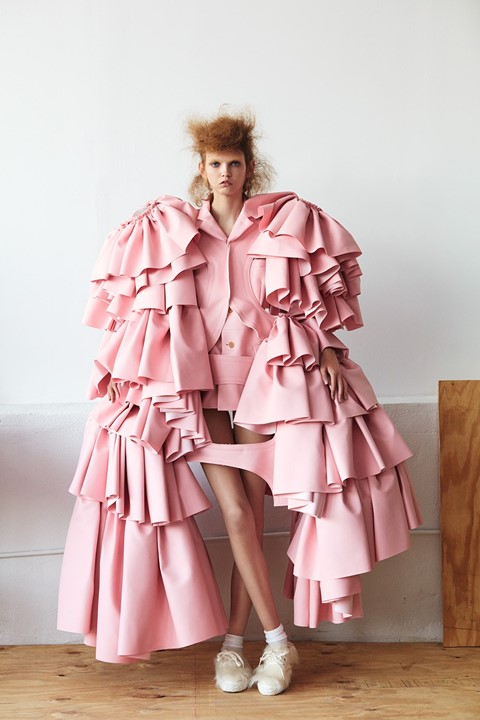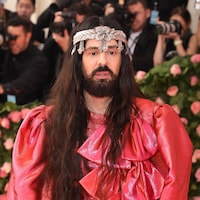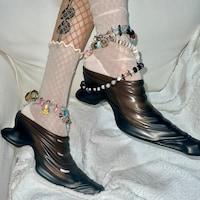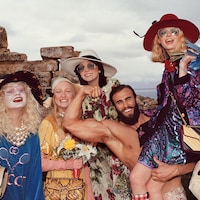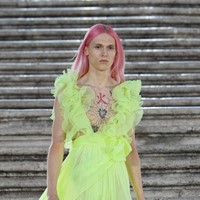Following last night’s Rei Kawakubo-themed Met Gala, we take an alphabetical tour of the avant-garde designer’s legacy
Bad Taste. Transcending Gender. Not Making Clothing. MONSTER. It sounds like the track listing for a particularly angry punk record, but these are in fact the names of some of the most angry, outrageous and beautiful collections by Japanese designer Rei Kawakubo, for her iconic label Comme des Garçons.
Kawakubo, who has dramatically changed what we consider to be fashion, is the subject of this year’s exhibition at the Met’s Costume Institute. Since her Paris debut in 1981, Kawakubo has challenged the status quo in both mens and womenswear with her radical use of references, proportion, and technique, in increasingly abstract shows. She’s also strayed from the norm with her innovative business model and stores – which other designer has championed and promoted her staff, as she has with Junya Watanabe and Kei Ninomiya, or gone on to open a series of department stores, as she did with the weird and wonderful Dover Street Market?
The Met exhibit, which she designed with curator Andrew Bolton, is Kawakubo to the core. It’s divided into distinctly Comme themes: past/present/future, model/multiple, order/chaos. Rather than being organised chronologically, the clothes are grouped in these categories, playing upon the themes that have obsessed Kawakubo throughout her career. What comes across most is her conviction that one should dress for oneself – her clothes both invite the male (or female) gaze with their wildness and repel it with their ungainly shapes that obscure and twist the body.
Throughout her career, Kawakubo has remained uniquely opposed to explaining herself or having others explain her, which makes the exhibition ever the more fascinating. Or perhaps confusing. As Bolton notes in the accompanying catalogue, Kawakubo defies description and hates interviews. Perhaps the best description, one fondly noted by Bolton, is one Kawakubo gave to AnOther Magazine’s Susannah Frankel when she was at The Independent – when Frankel asked Kawakubo to describe the now infamous Body Meets Dress-Dress Meets Body collection, Kawakubo simply drew a circle on a piece of paper.
Here is the dA-Zed of Rei Kawakubo and Comme des Garçons.
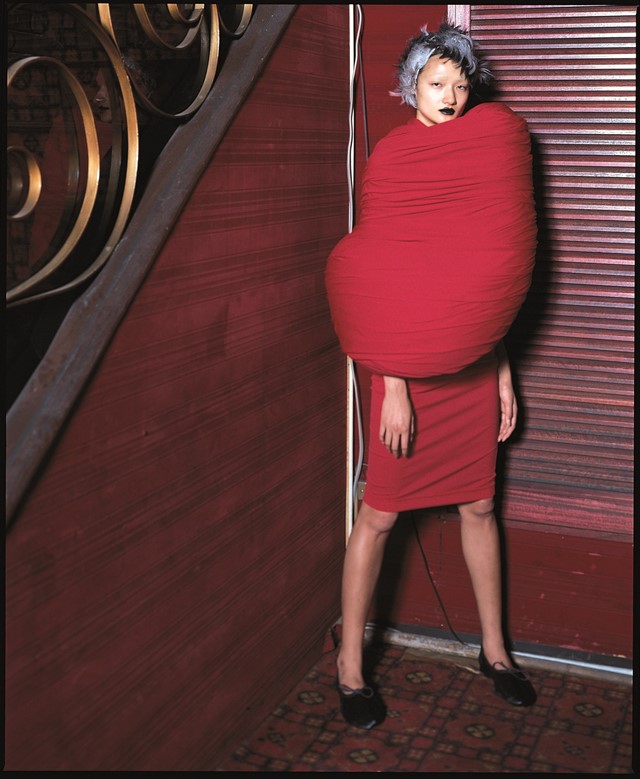
A IS FOR APOCALYPSE
When Kawakubo and her compatriot Yohji Yamamoto first showed in Paris in the spring of 1981, it had a seismic effect on the gathered fashion press. It was the opposite of the high fashion norm at the time, all Gianni Versace glamazons and wide shouldered Thierry Mugler tailoring. Their wild volumes, piratical cuts and disdain for gendered clothing, in an all black palette, were deemed apocalyptic, and in new lows of fashion criticism, ‘Hiroshima chic’ and ‘the bag lady look’. More fool them – over thirty years later, Kawakubo’s radical departure from fashion norms is seen as one of the defining moments in modern fashion, on the back of which she’s built an empire. The Comme des Garçons show is still a highpoint of the Paris schedule.
B IS FOR BLACK
Over the years Kawakubo may have deviated from her original monochrome colour scheme, but her defining palette is still black in its many forms. Her original flock of devotees were dubbed Karasu (see: K), the Japanese word for crows, for their noir-ish appearance in her designs. “If I could do an all black collection, then I would.” She told the Sunday Times in 1986. Over the years, this approach has softened. Ten years later, she noted that the colour she’d helped popularise was everywhere, telling Dazed, “Over the 20 years or so since I first showed black clothes in Paris, the colour has completely lost its specialness and strength.” Thus, her exploration of other shades, most notably red, which she denotes as a similarly strong colour. Blood & Roses, her SS15 collection, told a visceral story of desire and rage in an all red palette, the models looking like they’d just emerged from a massacre. Broken Bride (AW05) explored white and all its connotations, most obviously relating to the bridal gown – in Rei’s hands, the wedding party took on a distinctly doleful air. She took this to an extreme in 2012 with White Drama, an all-white collection that took our culture’s fixation on purity to the very extreme, with huge binding bows, suffocating white flowers and white, papery cages around the body.
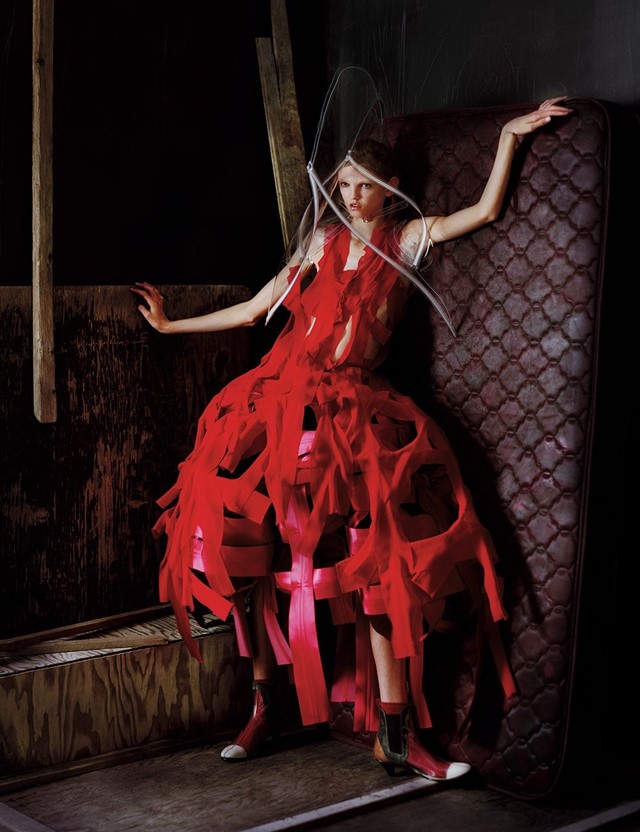
C IS FOR COLLECTIONS
Comme des Garçons collections have truly great names. Because Kawakubo is at pains never to explain her work, she titles each collection to give a (small) insight into her thought process. Bad Taste, 2 Dimensions, Infinity of Tailoring and Not Making Clothes are just some of the phrases she’s come up with to describe her design process. Perhaps the most famous, however, is Body Meets Dress–Dress Meets Body, for SS97. Looking at the collection, no other moniker could be more perfect – gingham dresses undulate around large foam protuberances, warping the shape of the wearer. This gave rise to another, more commonly used name - Lumps and Bumps. Kawakubo designed an aesthetically similar collection of costumes for American dancer and choreographer Merce Cunningham for his 1997 piece Scenario. Kawakubo knows the power of language, perhaps why she so disdains explaining herself. “I’d rather have no title. Journalists like titles. That’s why I give them to you,” she said in 2012.
D IS FOR DOVER STREET MARKET
The idea of a brand opening a multi-label department store sounds mad, but in 2004 that’s just what Comme des Garçons did, opening Dover Street Market in London on its namesake street. Inspired by Kensington Market, the meeting place that catered to first to hippies, then punks, new romantics and every other subculture in between until its untimely demise. The store, now located on Haymarket, sees Comme offerings displayed alongside brands ranging from Alaïa and Céline to Palace and Gosha Rubchinskiy. What unites them is a vision – Kawakubo only stocks designers she believes in. The store now has locations in New York, Tokyo’s Ginza and Beijing, united in Kawakubo’s mentality of beautiful chaos; a meeting place for all different types of people.
E IS FOR EPONYMOUS
It’s often wondered why Kawakubo didn’t simply name her label after herself – why the strange French turn of phrase? “I chose Comme des Garçons as a name because I liked the sound. It doesn’t mean much to me, I didn’t intend to promote myself, that’s why I didn’t put my name on it,” the designer explained in 1992. What it does mean is “Like some boys” like the Françoise Hardy lyric. At least that’s how the Met have translated it. It could also be read as “Like the boys” perhaps an insight into Kawakubo’s mentality (although she’d probably hate that).
F IS FOR FRAGRANCE
Comme des Garçons generates around $220 million a year in revenues, and a key part of that is their fragrance division. Under the supervision of Adrian Joffe (See J: Joffe), the brand released it’s first ‘anti-perfume’, Odeur 53, in 1998. It smelt of oxygen, nail polish and burnt rubber. Since then, in partnership with Puig, they’ve released genre defining scents such as Play, Amazing Green and Wonderwood. All their scents are so far from what perfume’s supposed to be; floral, ‘sexy’, or even worse, ‘mysterious’. Comme scents are unique in the way they marry weirdness with desirability, perhaps because of the sometimes abstract, sometimes mundane situations that inspire them. Dust on a hot lightbulb. Leaves after the rain. If gold had a fragrance, and so on. Always consistent, Kawakubo carries her ethos through everything she does.
G IS FOR GOSHA RUBCHINSKIY
There’s a reason Dover Street is full of skaters (or wannabe ones), and it’s mainly down to Rubchinskiy. The Russian designer made his first forays into design in 2008, before a fortuitous meeting with Adrian Joffe. Comme des Garçons then stepped in to produce and sell his collection, leaving him free to well, design. Over ten collections later, the collaboration has proved more than fruitful, with 150 stockists worldwide.
H IS FOR HOMME PLUS
The womenswear gets most of the press, but Kawakubo’s creations for men are just as brilliant. Homme Plus, her premiere men’s line, was started in 1978 and has since seen riffs on knights, childhood toys, Mexican cowboy culture and the Chanel jacket. Broken Tailoring is a typical collection title, illustrating Kawakubo’s fixation with traditional men’s dress. “The basics of clothing lie in men’s fashion,” she said in 1995. That being said, Kawakubo has said she doesn’t believe in the concept of male or female – just ‘human’.
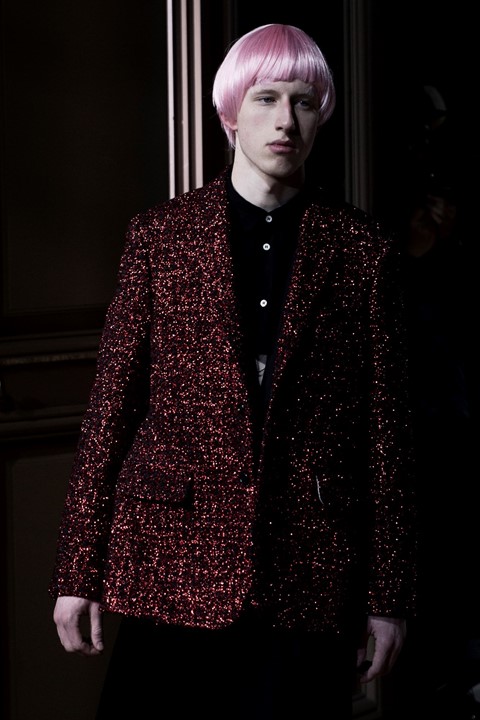
I IS FOR INSPIRATION
Kawakubo is characteristically tortured and secretive about her design process, as well as what influences her. She claims that she’s not at all influenced by what’s happening in fashion or culture. Instead, her ideas come from the everyday. “I have no inspiration. I never do. I am maybe triggered by something somewhere sometimes, but I am not conscious of it. I start without any theme and grope in the dark as I proceed,” she told Pen magazine in 2012.
J IS FOR JOFFE
Adrian Joffe is both president of Comme des Garçons International and Kawakubo’s husband since 1993. Joffe, who is South African and studied Zen Buddhism, acts in many capacities, overseeing the Dover Street Markets, the various brand offshoots, and the diverse design family that includes Junya Watanabe, Gosha Rubchinskiy and Kei Ninomiya. In this, he can be part credited with the brand’s visionary business model. Joffe also acts as Kawakubo’s translator during interviews, and once told the Financial Times that one of the things his wife had taught him was “Never answer a question directly.”
K IS FOR KACHIKAN
Comme des Garçons revolves around what Kawakubo calls Kachikan, or a set of values, and everything springs from it. The set of values is essentially this, according to Joffe; the desire to create something different. “Rei designs everything of the company,” he says. “Her values permeate everything that constitutes the brand; The clothes, the shops, the printed matter, the way the clothes look in in the shops, the name cards and the retail strategy, all cannot be separated.” This is Kachikan.
L IS FOR LAUGHING
One of the most iconic advertisements of all time belongs to Comme des Garçons. For AW88, Kawakubo selected a photograph by Jim Britt of his two daughters laughing, braces and all. It’s demonstrative of the outside of the box approach she takes to the company’s advertising, which has included works by Cindy Sherman and Andre Kertesz. Outside of conventional print advertising, Comme also produces a mail out which goes to their best clients and friends, for which they’ve collaborated with artists such as Ai Weiwei and Argentinian art collective Mondongo. “We asked the artists to give us the body of their work for Rei to reenvision,” Adrian Joffe told The Cut. “It involved a huge leap of faith on their part, but they have always been thrilled with the results, saying through the addition of Rei Kawakubo’s work they have seen their own work in a different light.”
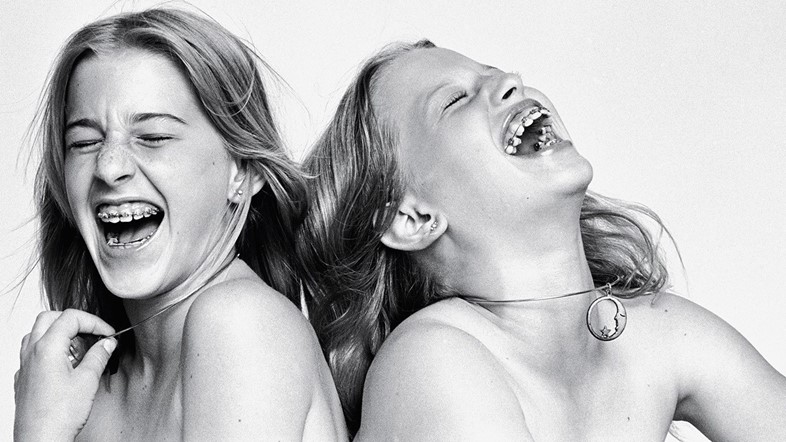
M IS FOR MET
Rei Kawakubo is only the second living designer to have a retrospective at the Costume Institute since Yves Saint Laurent in 1978, which didn’t go so well – it was pilloried for being ‘commercial’, whatever that means. As Kawakubo points out in the catalogue to curator Andrew Bolton, a glorious read in which she delights in gnomic responses, “but all art is commercial. It’s always been commercial – more today, in fact, than ever before.”
Having said that, the exhibition is perhaps one of the least commercial in Met history. 150 outfits stand poised in a set of her own design, which she had built in a warehouse space in Tokyo first. “What’s inspiring is that for her, the body and the dress body have no limits,” Andrew Bolton told the New York Times of the show, which is divided into non-chronological categories such as Absence/Presence, High/Low, Fashion/Antifashion and Object/Subject. Perhaps the most Instagram’ed section displays garments from the Body Meets Dress-Dress Meets Body show, which violently reimagined a woman’s sexuality with the enormous bumps swathed in sweet gingham that erupted from exactly where they shouldn’t be. What comes across is the absolute conviction she has.
In most interviews leading up to last night’s event, Kawakubo said she wasn’t going. Whether she approves of the exhibition or not, it’s sure to open Comme des Garçons up to a huge new audience, who even if they’re confused by what exactly ‘The Art of the Inbetween’ is, will hopefully buy something in the Comme gift store on the way out.
Prior to this glorious exit, however, they’ll go through one of the most mind-bending Met exhibitions ever.
N IS FOR NOIR KEI NINOMIYA
The latest line to join the Comme des Garçons family – Ninomiya was a pattern cutter at the main label – delights in the many ways in which fabric can be pleated, teased and folded into extraordinary shapes. All in black, obviously (although there’s been some red recently). Ninomiya studied French literature before becoming a designer, and his intimate salon shows have become a hot ticket. Ninomiya fills a niche previously occupied by Tao Kurihara. Kurihara’s strange, girlish aesthetic was much loved, especially when she took to making her intricate creations out of paper. She now designs the Tricot line.
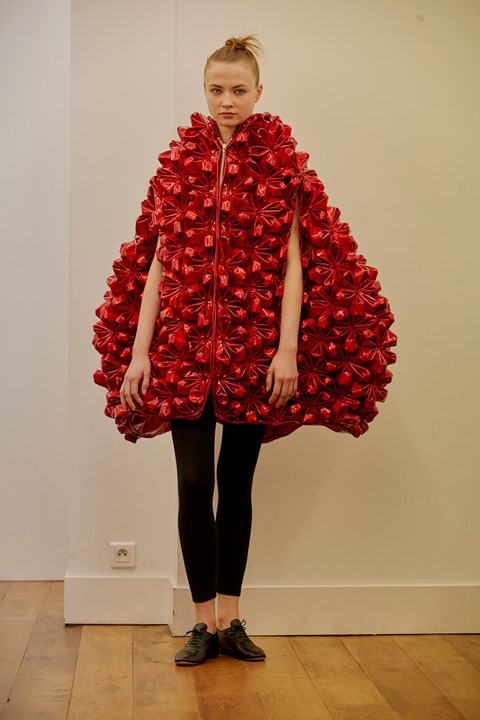
O IS FOR ORDINARY
One of the best things about Kawakubo is how ordinary she insists she is. In the seminal interview she gave to the New Yorker in 2005, she says “You think I’m not normal because you’re looking at the clothes. But I am. Can’t rational people create mad work?” the tendency is to characterise Kawakubo as a bit mad just because her work isn’t conventional, but this negates her brilliance as a businesswoman as well as a designer. She’s vocal about how hard the design process is to her – she doesn’t just skip around having wild ideas.
P IS FOR POP UP
Comme created the idea of a temporary store long before the concept entered the mainstream. Their first ‘guerilla’ store was in Berlin, selling previous seasons stock. The store was such a success they repeated the formula in other cities off the fashion radar such as Reykjavik, Athens, Beirut and Los Angeles. Come the recession in 2008, the concept also inspired their new line, Black, which reprised best-selling styles in all black (obviously) at a lower price, rather than cutting prices on their main line.
Q IS FOR QUESTIONS
Kawakubo really, really hates interviews. In the dialogue with curator Andrew Bolton contained within the Met exhibition catalogue, she, in fact, opens by saying “I really hate interviews,” and when reminded that it’s a conversation, says “That’s just a matter of semantics.” When designers are supposed to explain themselves endlessly after every season (and every moment in between), there’s something great about her reluctance, abhorrence even, of explaining anything at all.
R IS FOR RESPECT
Kawakubo is the ultimate designer’s designer, a fact perhaps best described by the ever voluble Marc Jacobs. When accused by Suzy Menkes of borrowing ideas from Comme for his SS08 collection, Jacobs told WWD “Jil Sander is influenced by Comme des Garçons, Miuccia Prada is influenced by Comme des Garçons, everyone is influenced by Comme des Garçons.” Jacobs then went on to wear an incredible Homme Plus lace dress to the Met Gala – one of the few instances of Comme on the red carpet.
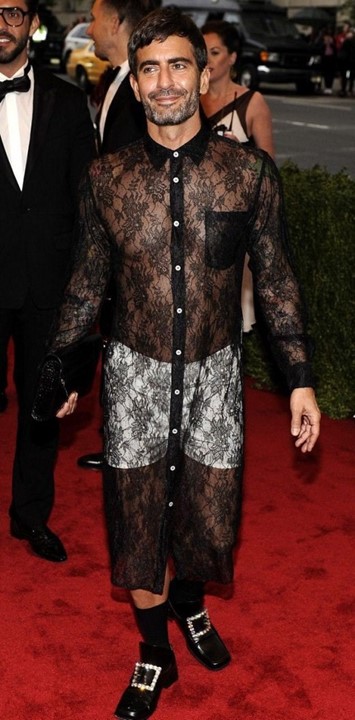
S IS FOR SIX MAGAZINE
Between 1989 and 1991, Comme des Garçons published its own biannual magazine, long before the concept was prevalent on the newsstands. It explored the theme of the sixth sense, and perhaps in keeping with its creator was sparse on text. Peter Lindbergh shot some of his best work for the magazine, chronicling Kawakubo’s early oversized aesthetic, and when she actually created pants and shirts in the main collection. It also featured contributions from Bruce Weber, Gilbert & George, and Azzedine Alaïa.
T IS FOR THEATRICS
Comme des Garçons shows are just that – a proper show. Whether to thundering opera Blood and Roses, SS15 or in slow motion to plaintive piano Ceremony of Separation AW15, recent shows have created a fantastical environment. A recent standout was AW17, named The Future of Silhouette, which closed with Anna Cleveland twirling down the runway with silver hair and voluminous gown that combined clouds of white foam with restrictive pleather protuberances. Kawakubo attributes this in part to her ‘rupture’ which started with SS14, when she lost interest in creating what looked like clothes. In fact, she says that it’s only these past seven collections which now interest her, and she would have preferred it be only these that were in the exhibition. Her non-clothes are just that – almost unwearable, often without holes for one’s hands or head, like moving sculptures that just happen to have a human on the inside.
U IS FOR UNCOMPROMISING
Since she first introduced Comme des Garçons Collection in 1969, the label has been sustained by Kawakubo’s devoted, uncompromising vision. One could wax lyrical about her originality but the reasons why Kawakubo is brilliant are well chronicled above. Instead, here’s one of the designer’s rather zen koans from 2012 to consider; “To me, designing is not all about designing. ‘Not designing’ is also designing to me.”
V IS FOR VOID
“The void is important,” said Kawakubo in 2000, and this is a concept her work often returns to – that of nothingness. As noted by Bolton, Kawakubo’s work is similar to a zen koan, the riddle used by Zen masters to evaluate their students progress towards enlightenment. A noted zen koan is mu, or the void, which can be interpreted as “negation, emptiness and nothingness,” according to Bolton. Kawakubo returns to this concept repeatedly in her work. Accepting an award in 2000, she explained, “I like to work with space and emptiness.”
W IS FOR WATANABE
Uniquely, Kawakubo takes employees she thinks have a particular vision and helps them open their own company within Comme des Garçons. Junya Watanabe was the first of such, starting as a pattern cutter at Comme before being promoted to chief designer of the Tricot line, and then opening his eponymous label in 1992. Watanabe, like his mentor, delights in the abstract when designing, but also takes a plethora of inspirations from subcultures – his punk outings are always particularly great. “Junya Watanabe,” she told the Wall Street Journal in 2011, “is a part of such a necessary company-expansion policy… collaborations have no meaning if 1+1 does not equal much more than 2.”
X IS FOR X
As in Comme des Garçons X Louis Vuitton, Comme des Garçons x Nike, Comme des Garçons x Vanson Leathers, Comme des Garçons x Converse – Kawakubo championed collaborating with heritage brands long before it was the norm. they’ve brought double benefits to the company, as not only to die-hard customers love them, but they bring Comme to a whole new audience (as evidenced by the little Comme heart with eyes on Converse sneakers worldwide). Whatever she does, the collabs always have her inimitable stamp upon them – witness the Vuitton handbag that’s full of holes.
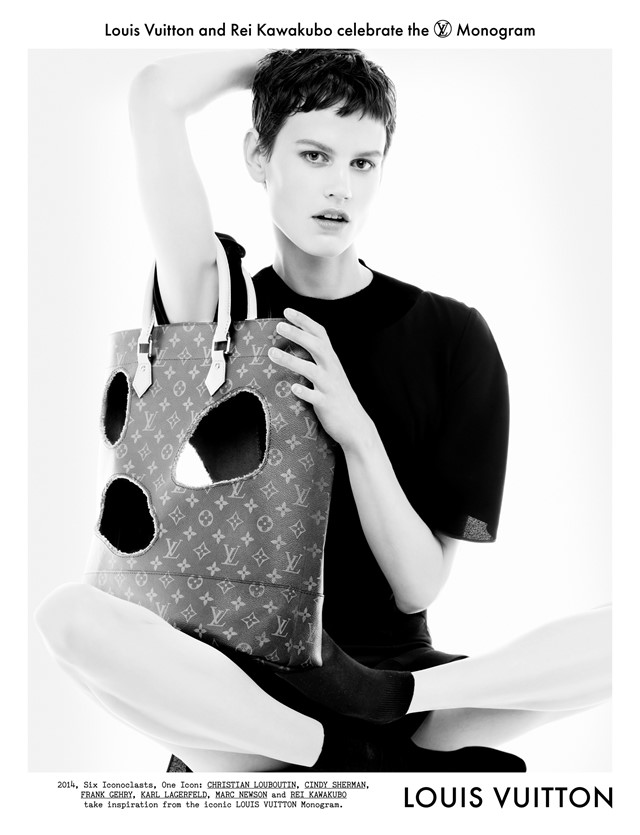
Y IS FOR D’YS
As in Julien D’Ys, the hair stylist whose abstract creations have contributed so much to the Comme des Garçons look. For Kawakubo, D’Ys has created enormous silver wigs, paint twisted locks and long witchy white wigs. D’Ys also contributed illustrations for the Met tome. “My collaboration with Rei has always worked very well, it’s just like magic with her,” he says of their 25-year spanning partnership. “She pushes me to go very far, and so I want to give the shows something new and different – I push myself so it’s perfect to respect the clothes.”
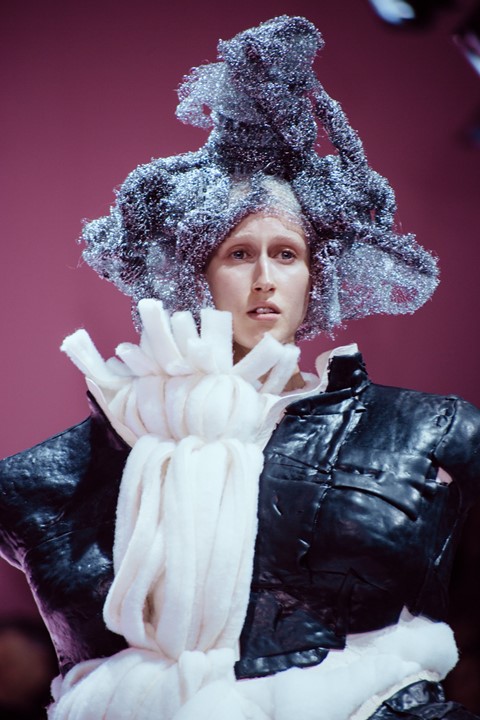
Z IS FOR ZIPPER WALLET
It might seem prosaic to end on the wallet, it’s become a mainstay of the Comme commercial empire, and perfectly represents the way that Kawakubo and Joffe have combined creativity and business sense. From the many coloured wallets to the Play line, which features the now iconic little heart with eyes, Comme has mastered expanding the signature aesthetic beyond just the main collection, so anyone can have a piece of it. The concept is not of diffusion lines, but extension – everything grows from the kachikan of Comme des Garçons, into what is now 17 different lines. Amazingly, Kawakubo herself still owns the vast majority of the Comme parent company – truly extending her concept of independence and strength throughout her universe.
It’s Comme week! From red carpet write ups to picks from the archive, head here for pieces celebrating the opening of The Met’s Art of the Inbetween exhibition.
